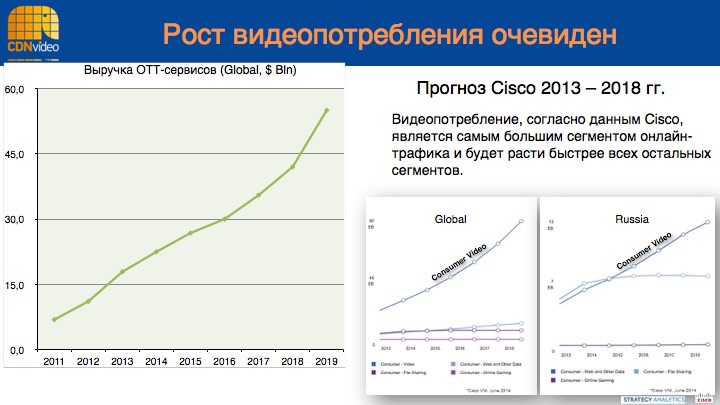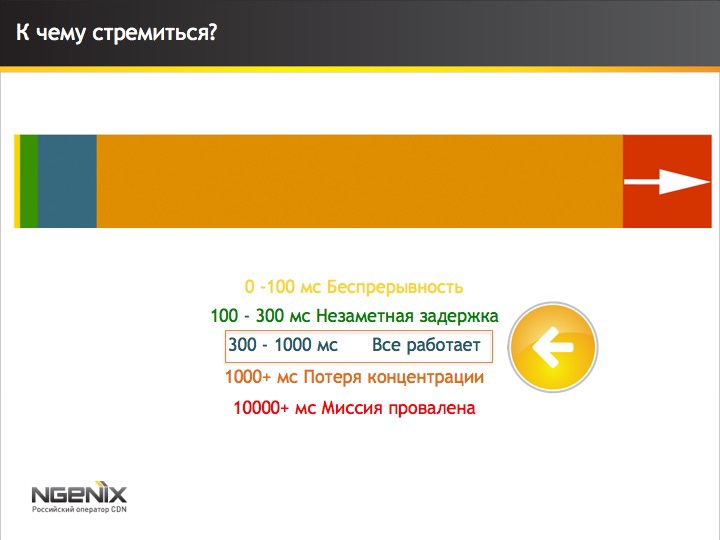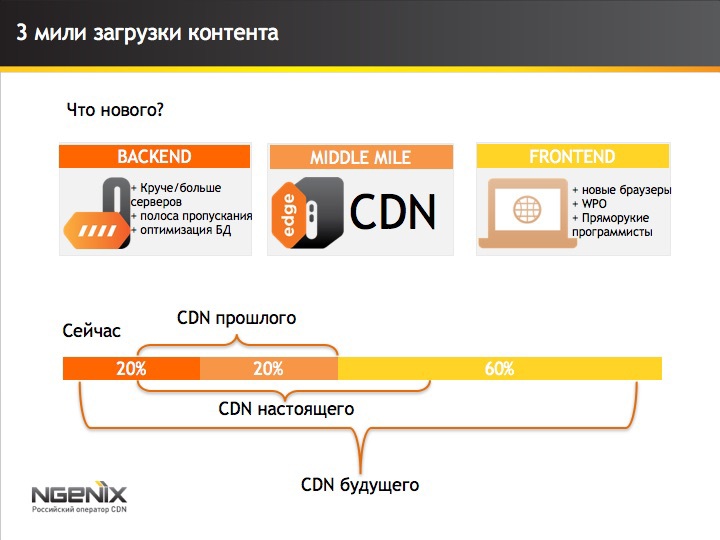10 interesting facts about CDN and site speed
CDNvideo Mini Encyclopedia about CDN

French writer Bernard Werber became famous for his "Encyclopedia of Relative and Absolute Knowledge." It contains short entertaining texts about everything in a row, as if pulled out of an encyclopedia. After the round table at the RIW conference organized by CDNvideo, where, in addition to us, NGENIX and Megafon gathered, we tried to compile our mini-encyclopedia, but specialized. We have gathered in it the numbers and facts about the CDN and everything around this service. As Werber used to say, they “make neurons sparkle,” or, more simply, they are suggestive.
')
The growth of global Internet traffic can be graphically represented by exhibitors:

The traffic is growing very fast - more and more content, and it is getting harder. It would seem that the number of players in the content delivery market, that is, the CDN, should grow about the same. However, since the first CDN networks appeared in 1998, a large number of CDN operators appeared and disappeared on the market. By 2001, there were more than 50 content delivery companies in the world, and in 2001, after the “dotcom crash”, the number of players decreased by several times. By 2004, there were only six of them left, but now - again around 50. The average growth rate of the CDN market in money is 25%.
In Russia, the average annual growth is almost 100%, and in 2015, according to our forecasts, which we did before the collapse of the national currency, in 2015 could be about $ 55 million. As for the sensitivity of the Russian market to shakes in the economy, it is the same as and all over the world. During the current crisis in Russia, the number of players, as well as the real volume of the market, may also decrease.
The turnover of the global market leader in content delivery, Akamai Technologies, is approximately $ 2 billion a year. There are no other players of comparable scale. But there are several large global companies with a turnover of $ 150-200 million - for example, Level 3 Communication or Microsoft (with the Microsoft Azure product). Russian companies so far only dream of being similar to them in terms of turnover, while some are not so much worried about the entry of Western companies into the Russian market (some of them are already here), as they are planning their own expansion abroad.
Major markets have their own leaders. In China, the largest CDN operator is ChinaCache, in South Korea - CDNetworks, in Japan - NTT Communications, in America and Europe - Akamai Technologies. In Russia, there is no clearly defined leader. Of course, we very much hope that we will become this leader - CDNvideo.
According to Cisco forecasts, by 2018, 85% of world traffic will be accounted for video on the Internet. Now, according to various estimates, this figure is 60-70% (in Russia, video accounts for 90% already). This is due not only to the "weighting" of video files. User behavior is increasingly shifting from surfing the web to spending time on entertainment resources. We are closely following this trend, because video is the main driver of the CDN market:

The market for selling digital content is very heterogeneous. The undisputed leader in it is the United States (27%), followed by Japan, the United Kingdom and South Korea. Russia accounts for only 2% of the world market. At the same time, Russia ranks first in Europe in terms of the number of Internet users, both existing and potential - those who enter the network irregularly.
Over the past 9 years, the average weight of an online store page has grown from 626 kb to 1677 kb. So much, according to the company NGENIX, weighed the average page of the online store in 2014. For this reason, CDN is becoming increasingly popular in electronic commerce. CDN technology is already using every fourth of the top 100 online stores in the US and Europe.
The most subtle, but frequent attention delay in our lives is blinking. It lasts from 0.1 to 0.3 seconds and is almost not realized. You need to focus to track how often you blink. If the delay in some process is shorter than blinking, then the brain will regard it as uninterrupted, if more - lose concentration. A delay of more than one second will be perceived as a pause, and not as an interruption. For this very second, all the world's largest online stores are struggling, trying to achieve such a speed of website opening and make it their competitive advantage:

The critical delay for an Internet user is 10 seconds. When the page opens for more than 10 seconds, the brain tells us: “Everything, does not work! Stop doing this task! Do something else! ”
According to Walmart, the world's largest retail chain, every second of a delay in opening a web page reduces conversion by an average of 7%. Another interesting fact: the growth of site speed can increase the number of conversions from search engines by 20% (meaning free, organic traffic). The reason is that Google and Yandex, among other factors, estimate the speed of sites when ranking them in search results.
The first method can be called naive. You need to ask friends or representatives of your company in different regions to evaluate the speed of the site loading. The second method is more advanced: use a network of probes that are located in data centers. The third is the most reliable one: put a specialized counter on your website that registers the behavior of users from different regions and the speed of loading pages in their browsers. There are many such counters - both independent (for example, a special “sensor” from Cedexis for estimating the download speed of the site and other related parameters, or a tool for measuring the speed of the site embedded in the 1C-Bitrix CMS) and provided by the CDN providers.
According to MegaFon, content providers or online stores do not always want to invest in fast content delivery, despite any arguments. The frequent answer is: "I am not interested in the regions - there is too small percentage of consumers." When there is an opportunity to save on the regions, the majority of entrepreneurs will do so. This is strange, because the runet has been growing by the regions for several years already, and investments in CDN make it possible to achieve a simultaneous effect in all regions and are not comparable in volume with the other costs of regional expansion - for example, opening warehouses and branches. In general, the reluctance to attract technology to accelerate access to sites for Internet users from the regions is the first problem of CDN operators.
The second big problem is that telecom operators often do not want to negotiate with each other about the exchange of traffic. As a result, traffic can go from one region remote from the center of the country to another through Moscow (and it’s good, if not through Amsterdam).
All heavy content is delivered to the user through three stages - three so-called “miles”: servers, networks and data centers, and a browser. According to NGENIX statistics, 10 years ago, the overwhelming number of problems - 65% - fell on the average mile (networks and data centers), browsers - 25%, and servers - 10%. Now the problem of an average mile has been solved, thanks in large part to CDN technology. The most problematic area now is browsers and other software from the user. Now 60% of problems are covered here:

The landscape of the Russian content delivery market is still emerging. It can affect a variety of factors. And further development will affect a variety of industries related to IT and the Internet - this is video, Internet commerce, the advertising business of large portals, hosting services, communications and many others. The day is not far off when the CDN will become one of the main topics in IT, which at different times were SMM and contextual advertising.
In the meantime, as the writer Viktor Pelevin would say, we are preparing to go out of the glamor into the discourse, and at the conference “RIF + CIB 2015” we will continue the discussion. Wait for new interesting facts about CDN and speed.

French writer Bernard Werber became famous for his "Encyclopedia of Relative and Absolute Knowledge." It contains short entertaining texts about everything in a row, as if pulled out of an encyclopedia. After the round table at the RIW conference organized by CDNvideo, where, in addition to us, NGENIX and Megafon gathered, we tried to compile our mini-encyclopedia, but specialized. We have gathered in it the numbers and facts about the CDN and everything around this service. As Werber used to say, they “make neurons sparkle,” or, more simply, they are suggestive.
')
The content market is always growing, but the market for its delivery is not
The growth of global Internet traffic can be graphically represented by exhibitors:

The traffic is growing very fast - more and more content, and it is getting harder. It would seem that the number of players in the content delivery market, that is, the CDN, should grow about the same. However, since the first CDN networks appeared in 1998, a large number of CDN operators appeared and disappeared on the market. By 2001, there were more than 50 content delivery companies in the world, and in 2001, after the “dotcom crash”, the number of players decreased by several times. By 2004, there were only six of them left, but now - again around 50. The average growth rate of the CDN market in money is 25%.
In Russia, the average annual growth is almost 100%, and in 2015, according to our forecasts, which we did before the collapse of the national currency, in 2015 could be about $ 55 million. As for the sensitivity of the Russian market to shakes in the economy, it is the same as and all over the world. During the current crisis in Russia, the number of players, as well as the real volume of the market, may also decrease.
In the global CDN market, there is one leader who can’t be caught up.
The turnover of the global market leader in content delivery, Akamai Technologies, is approximately $ 2 billion a year. There are no other players of comparable scale. But there are several large global companies with a turnover of $ 150-200 million - for example, Level 3 Communication or Microsoft (with the Microsoft Azure product). Russian companies so far only dream of being similar to them in terms of turnover, while some are not so much worried about the entry of Western companies into the Russian market (some of them are already here), as they are planning their own expansion abroad.
Major markets have their own leaders. In China, the largest CDN operator is ChinaCache, in South Korea - CDNetworks, in Japan - NTT Communications, in America and Europe - Akamai Technologies. In Russia, there is no clearly defined leader. Of course, we very much hope that we will become this leader - CDNvideo.
People watch a lot of videos and will watch even more.
According to Cisco forecasts, by 2018, 85% of world traffic will be accounted for video on the Internet. Now, according to various estimates, this figure is 60-70% (in Russia, video accounts for 90% already). This is due not only to the "weighting" of video files. User behavior is increasingly shifting from surfing the web to spending time on entertainment resources. We are closely following this trend, because video is the main driver of the CDN market:

Russia is a grain of sand in the digital content sales market
The market for selling digital content is very heterogeneous. The undisputed leader in it is the United States (27%), followed by Japan, the United Kingdom and South Korea. Russia accounts for only 2% of the world market. At the same time, Russia ranks first in Europe in terms of the number of Internet users, both existing and potential - those who enter the network irregularly.
Every year, websites are getting harder, and CDN is more important
Over the past 9 years, the average weight of an online store page has grown from 626 kb to 1677 kb. So much, according to the company NGENIX, weighed the average page of the online store in 2014. For this reason, CDN is becoming increasingly popular in electronic commerce. CDN technology is already using every fourth of the top 100 online stores in the US and Europe.
Downloading a site in a second is the dream of any online store.
The most subtle, but frequent attention delay in our lives is blinking. It lasts from 0.1 to 0.3 seconds and is almost not realized. You need to focus to track how often you blink. If the delay in some process is shorter than blinking, then the brain will regard it as uninterrupted, if more - lose concentration. A delay of more than one second will be perceived as a pause, and not as an interruption. For this very second, all the world's largest online stores are struggling, trying to achieve such a speed of website opening and make it their competitive advantage:

The critical delay for an Internet user is 10 seconds. When the page opens for more than 10 seconds, the brain tells us: “Everything, does not work! Stop doing this task! Do something else! ”
Site speed is a powerful factor in increasing online sales
According to Walmart, the world's largest retail chain, every second of a delay in opening a web page reduces conversion by an average of 7%. Another interesting fact: the growth of site speed can increase the number of conversions from search engines by 20% (meaning free, organic traffic). The reason is that Google and Yandex, among other factors, estimate the speed of sites when ranking them in search results.
There are three ways to measure site speed in different cities.
The first method can be called naive. You need to ask friends or representatives of your company in different regions to evaluate the speed of the site loading. The second method is more advanced: use a network of probes that are located in data centers. The third is the most reliable one: put a specialized counter on your website that registers the behavior of users from different regions and the speed of loading pages in their browsers. There are many such counters - both independent (for example, a special “sensor” from Cedexis for estimating the download speed of the site and other related parameters, or a tool for measuring the speed of the site embedded in the 1C-Bitrix CMS) and provided by the CDN providers.
The main “enemy” of the CDN is low population density
According to MegaFon, content providers or online stores do not always want to invest in fast content delivery, despite any arguments. The frequent answer is: "I am not interested in the regions - there is too small percentage of consumers." When there is an opportunity to save on the regions, the majority of entrepreneurs will do so. This is strange, because the runet has been growing by the regions for several years already, and investments in CDN make it possible to achieve a simultaneous effect in all regions and are not comparable in volume with the other costs of regional expansion - for example, opening warehouses and branches. In general, the reluctance to attract technology to accelerate access to sites for Internet users from the regions is the first problem of CDN operators.
The second big problem is that telecom operators often do not want to negotiate with each other about the exchange of traffic. As a result, traffic can go from one region remote from the center of the country to another through Moscow (and it’s good, if not through Amsterdam).
When downloading content passes three "miles"
All heavy content is delivered to the user through three stages - three so-called “miles”: servers, networks and data centers, and a browser. According to NGENIX statistics, 10 years ago, the overwhelming number of problems - 65% - fell on the average mile (networks and data centers), browsers - 25%, and servers - 10%. Now the problem of an average mile has been solved, thanks in large part to CDN technology. The most problematic area now is browsers and other software from the user. Now 60% of problems are covered here:

The landscape of the Russian content delivery market is still emerging. It can affect a variety of factors. And further development will affect a variety of industries related to IT and the Internet - this is video, Internet commerce, the advertising business of large portals, hosting services, communications and many others. The day is not far off when the CDN will become one of the main topics in IT, which at different times were SMM and contextual advertising.
In the meantime, as the writer Viktor Pelevin would say, we are preparing to go out of the glamor into the discourse, and at the conference “RIF + CIB 2015” we will continue the discussion. Wait for new interesting facts about CDN and speed.
Source: https://habr.com/ru/post/249799/
All Articles